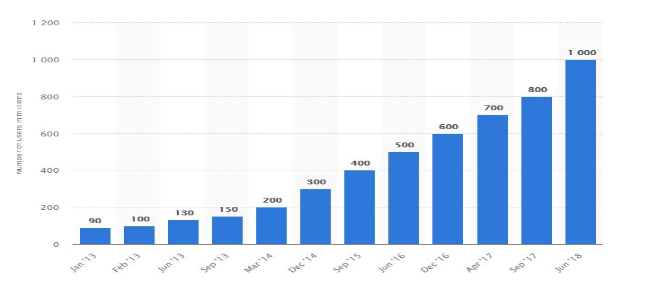With social media usage continuing to rise, influencer marketing is revolutionising the way companies engage with their consumers online. Despite this form of marketing being fairly new, it’s disrupting advertising and marketing norms and tactics, say members of the research team at Mellon1, part of BNY Mellon Investment Management.
With the global popularity of social media channels, companies all over the world have moved to advertise their products to reach audiences they may not be able to attract through traditional marketing and advertising measures. For example, Instagram has more than 1 billion active users2, while its rivals Twitter and Snapchat have more than 325 million and 125 million respectively. 3
Number of active users on Instagram (January 2013 to June 2018 - number of users in millions):

Source: Statista, 20 August 2019.
This is where influencer marketing comes into play. Leveraging the sense of trust influencers build with their followers, companies are using them to target online consumers and sell their products. For example, a cosmetics company may team up with a beauty influencer to advertise new makeup to the influencer’s followers, or an athletic apparel company may pay a fitness influencer to wear their clothes and post about it on their social media channels.
Therefore, the influencer gets paid to post about things they’d most likely use on a regular basis anyway and the company gets to reach a large audience within a matter of seconds, without having to pay as much as they would for a celebrity endorsement. The influencer marketing industry was said to be worth US$2bn in 2017, and is set to reach US$10bn in 2020.
Leigh Todd, senior research analyst at Mellon, comments: “Companies can get a lot more value with what they spend on influencers with a niche or unique following. A company can take all of the money they’d spend on a single celebrity product endorsement and spread those dollars across multiple influencers that may have a more targeted demographic appeal.”
Brian Blongastainer, equity research analyst at Mellon, adds: “Influencers with 30-50,000 followers have a five times higher sell through or engagement level than a celebrity. You’re going to get higher engagement per follower while using multiple influencers who represent the demographic or type of person you’re trying to cater your product to.”
This relationship between influencers and companies is what has fuelled the fire of influencer marketing and has resulted in a movement that has drastically disrupted consumer marketing across industries.
According to the Mellon analysts, when creating marketing plans and business models, many companies now factor in digital spend higher than television and radio advertising costs. Within that digital spend, there is an increase allocation specifically to social media advertising.
The importance of data
However, the rise of influencer marketing has also created a need for measuring metrics and data that further show how successful the influencer’s promoting tactics are.
“With the improvement in social commerce and being able to click through to websites from Instagram or buy direct from the application, companies can track how successful they are with a specific influencer. You can now track the ROI (Return of Investment) of that influencer, which is not something that’s been able to be done in the past,” says Blongastainer.
“There’s much more data that caters to social media outlets now than there was five years ago,” adds Todd. “You can classify and identify the user demographics and interests on different types of social media applications. If you can target the influencers who are engaging with the demographic you’re interested in reaching, it gives you direct access to your potential customer,” she says.
Today, many private companies track social media scores and data in order to evaluate the success of influencers, who in turn can also use the information as a way persuade companies to invest in them.
How many ‘likes’ an influencer gets on posts isn’t as important as one may think though. “The likes have less value now,” says the research team at Mellon. “Now that you have the tools to track where people go when they view an Instagram post, that’s where companies are really going to measure the importance of influencer marketing. We think influencers are still going to be a very large part of marketing going forward but there is going to be some transition to other forms of social media to attract people.”
Although social media doesn’t look like it’s going to be declining in popularity anytime soon, Todd and Blongastainer believe the adoption rates may slow. “We think influencer marketing will continue to grow, we just don’t think it will grow at the same percentage rate,” they say.
But will that change the way companies are starting to advertise? Not necessarily. “It’s all going to come down to the return on the investment a company is making on the influencer. I think we’ll get closer to being able to identify the return on that advertising dollar spend through seeing how many people click through to purchase what the influencer is promoting, and analysing the behaviour of the customers after they see the ad, so it will naturally reduce the number of influencers that aren’t generating a return for these companies,” concludes Blongastainer.
For Professional Clients only. Any views and opinions are those of the interviewee, unless otherwise noted. This is not investment research or a research recommendation for regulatory purposes.
For further information, visit the BNY Mellon Investment Management website
1 Investment Managers are appointed by BNY Mellon Investment Management EMEA Limited (BNYMIM EMEA), BNY Mellon Fund Management (Luxembourg) S.A. (BNY MFML) or affiliated fund operating companies to undertake portfolio management activities in relation to contracts for products and services entered into by clients with BNYMIM EMEA, BNY MFML or the BNY Mellon funds.
2 TechCrunch: ‘Instagram hits 1 billion monthly users, up from 800M in September’, 20 August 2019.






